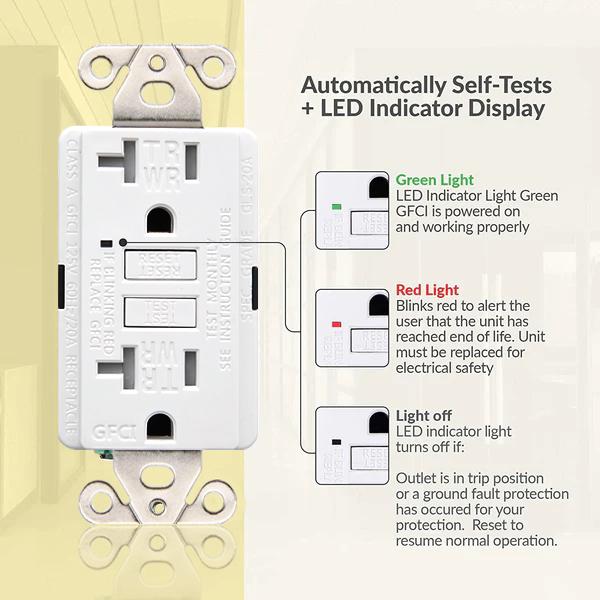Professionals often find themselves fielding questions from homeowners, and one query that frequently arises is: What is a GFCI outlet, and where should they be installed?
TABLE OF CONTENTS
l Let’s Begin with Defining a GFCI Outlet
l Unraveling Ground Faults
l Different Types of GFCI Devices
l Strategic Placement of GFCIs
l The Process of Wiring a GFCI Outlet Receptacle
l Incorporating Tamper-Resistant, Weather-Resistant, and Self-Test GFCIs
l It’s Easier Than You Think
LET’S BEGIN WITH DEFINING A GFCI OUTLET
GFCI is an acronym for Ground Fault Circuit Interrupter, also commonly known as GFIs or Ground Fault Interrupters. A GFCI meticulously monitors the equilibrium of electrical current flowing through a circuit. If the current strays from its designated path, as in the case of a short circuit, the GFCI promptly interrupts the power supply.
A GFCI serves as a critical safety feature, preventing fatal electrical shocks by swiftly halting the flow of electricity during a short circuit. This function sets it apart from arc fault circuit breakers or outlets like the Faith AFCI receptacles, which focus on identifying and disabling slow electrical “leaks,” such as those caused by puncturing a wire in a bedroom wall.
UNRAVELING GROUND FAULTS
Ground faults are most likely to occur in areas with water or moisture, posing a significant risk around homes. Water and electricity don’t mix well, and various spaces inside and outside the home bring them into close proximity. To ensure the safety of your family, all switches, sockets, breakers, and circuits in relevant rooms and areas should be GFCI-protected. In essence, a GFCI outlet could be the crucial element that safeguards your family in the event of a tragic electrical mishap.
A ground fault refers to any electric path between a current source and a grounded surface. It happens when AC current “leaks” and escapes to the ground. The significance lies in how this leakage occurs—if your body becomes a path to the ground for this electric escape, it can lead to injuries, burns, severe shocks, or even electrocution. Given that water is an excellent conductor of electricity, ground faults are more prevalent in areas near water, where water provides a conduit for electricity to “escape” and find an alternative path to the ground.
DIFFERENT TYPES OF GFCI DEVICES
While you might have come here seeking information about GFCI outlets, it’s worth noting that there are three basic types of GFCI devices:
GFCI Receptacles: The most common GFCI in residential homes is the GFCI receptacle, which replaces a standard outlet. Compatible with any standard outlet, it can protect other outlets downstream, i.e., any outlet receiving power from the GFCI outlet. The shift from GFI to GFCI reflects this focus on protecting entire circuits.
GFCI Outlets: Typically larger than standard outlets, GFCI outlets occupy more space in a single or double gang electrical box. However, advancements in technology, such as the Faith Slim GFCI, have reduced their size significantly. Wiring a GFCI outlet is a manageable task, but correct installation is crucial for downstream protection.
INCORPORATING TAMPER-RESISTANT, WEATHER-RESISTANT, AND SELF-TEST GFCIs
In addition to standard GFCI features, modern outlets also come with added safety measures. Tamper-resistant GFCIs feature built-in safeguards against foreign objects, preventing accidental electric shock. Weather-resistant GFCIs are designed for outdoor use, equipped to withstand the elements, ensuring uninterrupted safety even in adverse weather conditions. Self-test GFCIs automate the testing process, regularly checking their functionality without requiring user intervention.
WIRING A GFCI OUTLET RECEPTACLE
While we have a separate article on wiring a GFCI outlet, many homeowners can successfully complete the task by following the provided instructions. It’s imperative to cut power to the breaker before commencing the wiring process. If uncertainty arises, it’s advisable to seek professional assistance.
To test the GFCI receptacle post-installation, plug a device (e.g., a radio or light) into the outlet and turn it on. Press the “TEST” button on the GFCI to ensure the “RESET” button pops out, causing the device to turn off. If the “RESET” button pops out but the light remains on, the GFCI has been improperly wired. If the “RESET” button fails to pop out, the GFCI is defective and requires replacement. Pressing the “RESET” button reactivates the circuit, and inexpensive GFCI-compatible circuit testers are also available for purchase.
IT’S EASIER THAN YOU THINK
Ground Fault Circuit Interrupters are a crucial component of any home’s electrical system. When rewiring or updating your house to meet current code standards, pay careful attention to the placement of GFCI outlets. This simple addition can significantly enhance the safety of your family.
EXPERIENCE SAFETY WITH FAITH ELECTRIC GFCI OUTLETS!
Elevate your home’s safety with Faith Electric‘s premium GFCI outlets. We go beyond standard protection by offering tamper-resistant, weather-resistant, and self-test GFCIs. Trust Faith Electric for unparalleled safety and cutting-edge technology. Secure your family today!
Post time: Dec-13-2023


